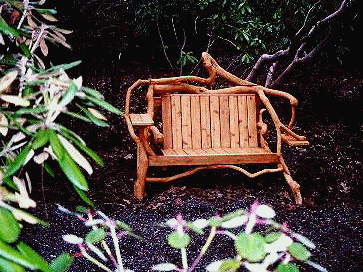|
PROPORTION
It took several tries to
get the height right for the bench at the top of this page. Sitting
at the edge of a 50 foot circle of lawn, the back didn't look
right until it was a semi-circle starting at the top of the arms.
The large double Rhododendron
Bench #9 had a similar problem. When the low backs were installed,
they were overpowered by the mass of the 8-foot high structure.
But they were just right for a low-lying
double.
Arms and legs can be disproportionate
too. Thickness, as well as length, should be evaluated. The Rhododendron Chair's short, heavy legs accentuate
its squat appearance.
The best way to achieve proportion
in garden furniture is to experiment with different sizes, look
at the results, and be willing to make adjustments.
|
COMPLEXITY
Like the contradictory tendencies
in nature toward and away from symmetry, the natural world can
look simple or complex depending on the level of observation.
Simple and complex garden furniture designs are both appropriate
if they have a purpose.
In the Deodara
Cedar Bench, I struggled with several styles of arms. All
detracted from the simple seat and back, supported by two large
chunks of the tree broken in a windstorm. The solution for the
cleanest design was no arms at all.
In contrast, the complexity
of the cage benches
or the finger bench creates the
interest. Intricate lines of small branches fill the eyes. The
cages enclose while the fingers lift upward.
Simple and complex both work
(but not in the same bench,)
|

